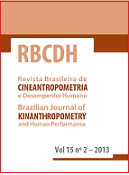Características antropométricas, morfológicas e do somatotipo de atletas voleibolistas da seleção brasileira masculino: estudo descritivo de 11 anos (1995-2005).
DOI:
https://doi.org/10.1590/1980-0037.2013v15n2p184Resumo
O presente estudo teve por objetivo analisar, no período de 11 anos, as características antropométricas e morfológicas de atletas da seleção brasileira masculina de voleibol. A amostra foi composta por 92 atletas convocados entre os anos de 1995 a 2005. Foram coletadas medidas antropométricas e estimados valores de composição corporal e componentes do somatotipo. Para a análise dos dados usou-se a estatística descritiva, a ANOVA one-way e Bonferroni, com significância de p<0,05. Ao longo dos 11 anos, houve aumento significativo nos perímetros do braço contraído, no diâmetro do úmero e na massa livre de gordura. Além disso, a espessura de pregas cutâneas e o percentual de gordura tenderam a diminuir. Estatura elevada foi uma característica presente ultrapassando na média 1.97 m. O somatotipo dos atletas da Seleção Brasileira modificou-se ao longo dos anos. As configurações mais presentes nos atletas foram a ectomorfismos e mesomorfismo. Conclui-se que, ao longo dos 11 anos, os atletas selecionados apresentaram um aumento da massa muscular, diminuição na espessura das pregas cutâneas e no percentual de gordura. As classificações antropométricas mais frequentes foram: Mesomorfo-ectomorfo durante cinco anos, seguida da classificação meso-ectomorfo com três anos. Sugerindo que nas convocações dos atletas, a estatura elevada e o baixo componente de gordura corporal foram considerados.
Downloads
Publicado
Edição
Seção
Licença

Direitos Autorais para artigos publicados nesta revista são do autor, com direitos de primeira publicação para a revista. Em virtude da aparecerem nesta revista de acesso público, os artigos são de uso gratuito, com atribuições próprias, em aplicações educacionais e não-comerciais, desde que seja dada a atribuição. Esta obra foi licenciada com uma Licença Creative Commons Atribuição 4.0 Internacional - CC BY


